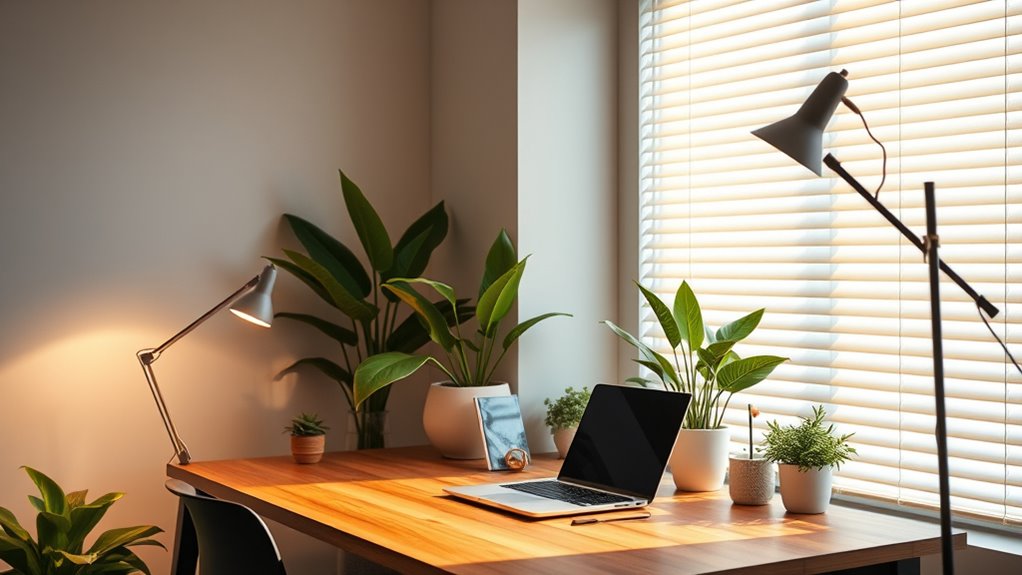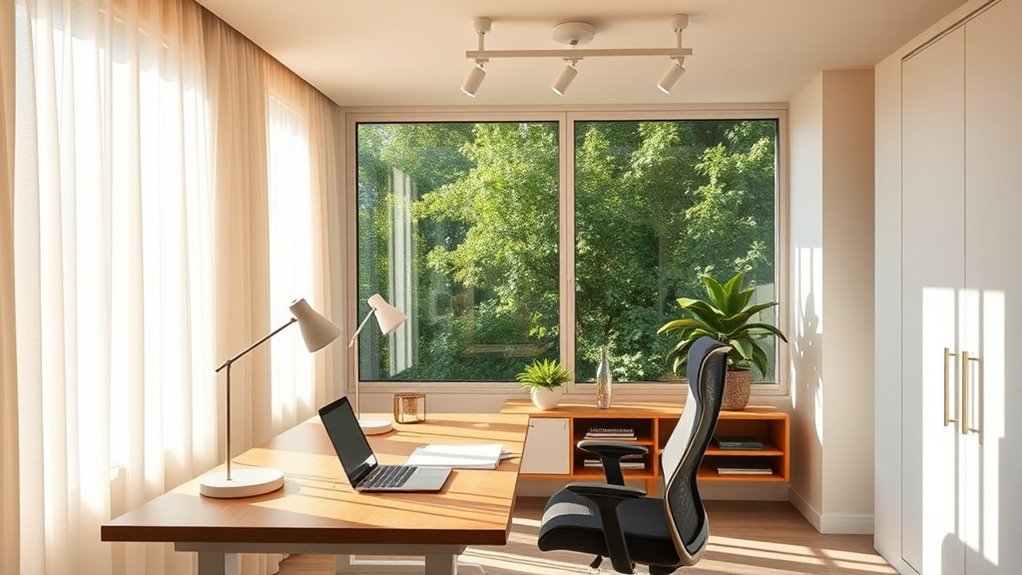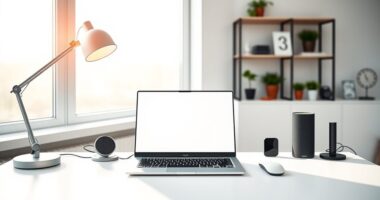To boost your productivity at home, focus on a well-lit workspace that combines natural light with layered artificial lighting. Position your desk near windows to maximize daylight, using adjustable task lamps to reduce eye strain during detailed tasks. Choose bulbs with a color temperature of 4000K to 5000K for natural energy and select light, neutral colors to reflect light and create a calm environment. If you want to discover more ways to optimize your lighting, keep exploring the tips ahead.
Key Takeaways
- Maximize natural light by positioning your desk near windows and using adjustable blinds to control glare.
- Incorporate layered lighting with overhead lights and focused task lamps to reduce eye strain.
- Choose bulbs with a color temperature of 4000K to 5000K for a bright, daylight-like environment.
- Use light, neutral colors in your workspace to reflect light and create an open, inviting atmosphere.
- Regularly take breaks and incorporate eye care to prevent fatigue and enhance overall productivity.

Creating the right lighting in your home office is essential for productivity and comfort. When your workspace is well-lit, you can focus better, reduce eye strain, and feel more energized throughout the day. To achieve this, start by considering your overall setup. Incorporate ergonomic furniture that promotes good posture and reduces fatigue, as it complements a well-lit environment by keeping you comfortable during long work sessions. Proper lighting enhances the functionality of your ergonomic desk and chair, making it easier to stay attentive and engaged.
Effective home office lighting boosts focus, reduces eye strain, and enhances comfort for long, productive work sessions.
Color schemes play a significant role in how effective your lighting feels. Lighter, neutral colors such as soft whites, beiges, or light grays reflect more light, brightening up the space naturally and making your environment feel more open and inviting. If you prefer a pop of color, choose calming shades like muted blues or greens, which can help keep you focused without overwhelming your senses. These color schemes work synergistically with your lighting to create a balanced atmosphere that boosts productivity without causing eye fatigue.
Natural light should be your first priority whenever possible. Position your desk near a window to maximize daylight, which is not only free but also supports your circadian rhythm, helping you stay alert during the day. Use sheer curtains or blinds to control glare, especially when the sun is at its peak. In addition to natural light, incorporate layered lighting options. Overhead lighting provides general illumination, but it can sometimes be too harsh or uneven. To counter this, add task lighting—like adjustable desk lamps—that allows you to direct light where you need it most. This reduces the need to strain your eyes or squint, especially when reading or working on detailed tasks.
Choose light bulbs with a color temperature around 4000K to 5000K, which mimics natural daylight and helps maintain alertness. Avoid overly warm yellow lights, which can make your workspace feel cozy but might also induce drowsiness. Conversely, overly cool or bluish lighting can cause discomfort and eye strain over time. Position your task lights to prevent shadows and glare on your screen, ensuring your workspace remains well-lit from every angle. Additionally, incorporating eye patches or other eye care products into your routine can help protect your eyes from strain caused by prolonged screen exposure.
Finally, consider the overall harmony between your lighting, furniture, and color scheme. When these elements are aligned, your home office becomes not just a functional space but a comfortable haven that inspires focus and efficiency. Proper lighting, combined with thoughtful design choices, transforms your workspace into an environment where you can work comfortably and productively all day long.
Frequently Asked Questions
What Type of Lighting Is Best for Reducing Eye Strain?
To reduce eye strain, you should choose lighting with a comfortable color temperature, around 4000K to 5000K, which mimics natural daylight. Opt for fixtures that offer glare reduction, such as diffused or shaded lights, to prevent harsh reflections on your screen. Avoid overly bright or flickering lights, and position your light sources to minimize direct glare, helping your eyes stay comfortable during long work sessions.
How Can I Adjust Lighting for Different Times of Day?
To modify your lighting for different times of day, start by maximizing natural light during daylight hours, positioning your workspace near windows and using sheer curtains to regulate glare. In the evening, switch to warm, adjustable artificial lighting, like desk lamps, and consider repositioning lights for even lighting. Proper lighting placement ensures your eyes stay comfortable and your workspace remains well-lit, no matter the time.
Are Smart Lighting Options Suitable for Home Offices?
Imagine your home office as a symphony, where smart bulbs play the perfect tune. Smart lighting options are highly suitable, as they allow you to tailor your environment for focus and comfort. With voice control, you can effortlessly adjust brightness or color, transforming your space with a simple command. These innovative features help create the ideal ambiance, boosting your productivity while adding convenience and a touch of tech-savvy flair.
How Does Lighting Influence Mood and Motivation?
Lighting considerably influences your ambient mood and motivation boost throughout the day. When you use natural or well-designed artificial lighting, it creates a comfortable environment that lifts your spirits and keeps you focused. Bright, warm lights can energize you, while softer lighting helps you relax. Proper lighting minimizes eye strain and fatigue, directly enhancing your mood and motivation. So, choosing the right lighting makes a measurable difference in your productivity and overall well-being.
What Are Eco-Friendly Lighting Solutions for a Home Office?
Eco-friendly lighting solutions for your home office include using energy-efficient bulbs like LEDs, which consume less power and last longer. You can also opt for solar-powered fixtures, harnessing sunlight to illuminate your workspace sustainably. These options reduce your carbon footprint while providing ample light. By choosing eco-conscious lighting, you support the environment and enjoy cost savings, making your workspace both eco-friendly and functional.
Conclusion
By tweaking your home office lighting, you create a workspace that feels bright and inviting, like a warm sunrise ready to energize your day. Proper lighting helps you focus, reduces eye strain, and keeps your mood uplifted as you work through tasks. Imagine your space bathed in just the right glow, making every keystroke and brainstorm feel natural and effortless. With these tips, your home office becomes a sanctuary where productivity and comfort shine together.









